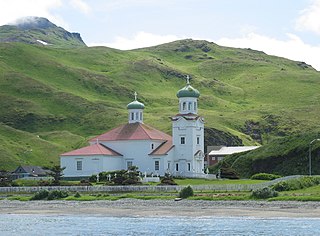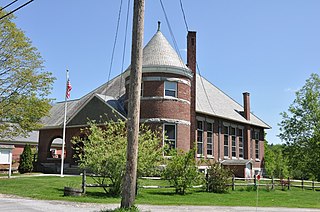
The Auditorium Building in Chicago is one of the best-known designs of Louis Sullivan and Dankmar Adler. Completed in 1889, the building is located at the northwest corner of South Michigan Avenue and Ida B. Wells Drive. The building was designed to be a multi-use complex, including offices, a theater, and a hotel. As a young apprentice, Frank Lloyd Wright worked on some of the interior design.

Sheldon Jackson College (SJC) was a small private college located on Baranof Island in Sitka, Alaska, United States. Founded in 1878, it was the oldest institution of higher learning in Alaska and maintained a historic relationship with the Presbyterian Church. The college was named in honor of Rev. Sheldon Jackson, an early missionary and educational leader in Alaska.

Sitka National Historical Park is a national historical park in Sitka in the U.S. state of Alaska. It was redesignated as a national historical park from its previous status as national monument on October 18, 1972. The park in its various forms has sought to commemorate the Tlingit and Russian experiences in Alaska.

St. Michael's Cathedral is a cathedral of the Orthodox Church in America Diocese of Alaska, at Lincoln and Maksoutoff Streets in Sitka, Alaska. The earliest Orthodox cathedral in the New World, it was built in the nineteenth century, when Alaska was under the control of Russia, though this structure burned down in 1966. After 1872, the cathedral came under the control of the Diocese of Alaska. It had been a National Historic Landmark since 1962, notable as an important legacy of Russian influence in North America and Southeast Alaska in particular.

Kenworthy Hall, also known as the Carlisle-Martin House, Carlisle Hall and Edward Kenworthy Carlisle House, is a plantation house located on the north side of Alabama Highway 14, two miles west of the Marion courthouse square. It was built from 1858 to 1860 and is one of the best preserved examples of Richard Upjohn's distinctive asymmetrical Italian villa style. It is the only surviving residential example of Upjohn's Italian villa style that was especially designed to suit the Southern climate and the plantation lifestyle. It has a massive four-story tower, windows of variable size and shape with brownstone trim, and a distinctly Southern division of family and public spaces. The building was designed and constructed for Edward Kenworthy Carlisle as his primary family residence and the centerpiece of his 440-acre (1.8 km2) estate. It, along with some of its surrounding ancillary structures, was declared a National Historic Landmark in 2004. The house and a purported ghost are featured as a short story in Kathryn Tucker Windham's 13 Alabama Ghosts and Jeffrey.

Castle Hill also known as the American Flag-Raising Site and now as the Baranof Castle State Historic Site, is a National Historic Landmark and state park in Sitka, Alaska. The hill, providing a commanding view over the city, is the historical site of Tlingit and Russian forts, and the location where Russian Alaska was formally handed over to the United States in 1867. It is also where the 49-star United States flag was first flown after Alaska became a state in 1959.

The Church of the Holy Ascension, also known as the Holy Ascension Orthodox Church, is a prominent landmark in Unalaska, the major community of the western Aleutian Islands in southwestern Alaska. The current church was built in 1894, probably on the site of an 1826 church, and likely using timbers and other elements from the older church. It is one of the oldest churches in Alaska, and is significant as the site from which missionaries brought their religion to the local Aleut people. This evangelization effort was so successful that today's Aleut population is still strongly Orthodox. The church was declared a National Historic Landmark for its architecture, and for its role in the history and culture of Alaska. It is the second cathedral church of the Orthodox Church in America Diocese of Alaska, after St. Michael's Cathedral in Sitka.

The Russian-American Building No. 29, also known as Tilson Building or Building No. 29, Sitka, is a historic commercial building at 202-206 Lincoln Street in Sitka, Alaska. A National Historic Landmark, it is the only Russian colonial commercial structure standing in Sitka, and one of only two Russian colonial buildings in the city

The Alaska Native Brotherhood (ANB) and its counterpart, the Alaska Native Sisterhood (ANS), are two nonprofit organizations founded to address racism against Alaska Native peoples in Alaska. ANB was formed in 1912 and ANS founded three years later. For the first half of the 20th century, they were the only organizations working for the civil rights of Alaska Natives in the territory and state.

Benjamin Church House is a Colonial Revival house at 1014 Hope Street in Bristol, Rhode Island, U.S.A. It opened in 1909 as the "Benjamin Church Home for Aged Men" as stipulated by Benjamin Church's will. Beginning in 1934, during the Great Depression, it admitted women. The house was closed in 1968 and became a National Register of Historic Places listing in 1971. The non-profit Benjamin Church Senior Center was incorporated in June 1972 and opened on September 1, 1972. It continues to operate as a senior center.

The Golden Rod Grange No. 114 is a historic Grange hall on New Hampshire Route 32 in Swanzey, New Hampshire, United States. Built in 1916, it continues to occupy a significant place in the community as a meeting and function space. The little-altered building was listed on the National Register of Historic Places in 1994. It is now owned by the town and maintained by the Swanzey Preservation Society.

The Massanetta Springs Historic District is a retreat in Rockingham County, Virginia, administered by the Presbyterian Synod of the Mid-Atlantic, and chiefly associated with the Massanetta Springs Summer Bible Conference Encampment. The district includes the Hotel (1910), Hudson Auditorium (1922) and Camp Massanetta (1955–56). A Methodist camp existed at the site, originally known as Taylor's Springs, from 1816.

The Redoubt St. Archangel Michael Site, also known as the Old Sitka Site and now in Old Sitka State Historical Park, is a National Historic Landmark near Sitka, Alaska. Now of archaeological interest, the site, about 7 miles (11 km) north of Sitka at the end of Halibut Point Road, was the site of the early Russian-American Company settlement known as Redoubt St. Archangel Michael. It was the first non-Native settlement on Baranof Island. It was declared a National Historic Landmark in 1962, and was made a state park in 1966.

The Struthers Library Building, also known as the Library Theatre, is an historic, American library and theatre building that is located in Warren, Warren County, Pennsylvania.

The Russian Bishop's House, once the Russian Mission Orphanage, is a historic house museum and National Historic Landmark at Lincoln and Monastery Streets in Sitka, Alaska. Built in 1841–43, this log structure is one of the oldest surviving buildings of Russian America, and was one of the centerpieces of the Russian Orthodox church's efforts to spread its influence among the natives of Alaska. It was the home and administrative center of Ivan Veniaminov, the first Bishop of Alaska, later canonized as Innocent of Alaska. The house is now a unit of Sitka National Historical Park, and is administered by the National Park Service.

Pillsbury Memorial Hall, located at 93 Main Street, is the town hall of Sutton, New Hampshire. It was built in 1891, funded by a gift from New Hampshire native John Sargent Pillsbury, founder of the Pillsbury Company and a leading Minnesota politician. It is the only Romanesque style town hall building in Merrimack County. The building was listed on the National Register of Historic Places in 1993.

The Hanlon-Osbakken House, also known as the Osbakken House, is a historic house at 419 Lincoln Street in Sitka, Alaska. Built c. 1892–96, this two-story wood-frame structure is one only two surviving Queen Anne Victorian buildings in the city. It has a side-gable roof which extends down to the first floor on the left side of the main facade, sheltering a porch. On the right side, there is a projecting bay window on the first floor, above which rises an octagonal tower-like dormer topped by a pyramidal roof. The house was originally built as a rectangular block with a center hall plan, but this was turned into an L shape by an 1896 addition at the rear. The house was built by William Basil Sherigan for his sister-in-law Anna and her husband, John Hanlon. Their daughter, Margaret Hanlon Osbakken, lived in the house until 1991.

The Former Greenwood Town Hall is located at 270 Main Street in Locke Mills, the main village of Greenwood, Maine. Completed in 1931, the building has been a center of civic and social activities since, hosting town meetings, elections, school graduations, dances, and private functions. It was replaced as town hall by the present facilities in 1988, and is now maintained by a local non-profit. It was listed on the National Register of Historic Places in 2001.

The West Rutland Town Hall is located at Main and Marble Streets in the village center of West Rutland, Vermont. Built in 1908-09, it is a fine and restrained example of Colonial Revival architecture, and originally housed town offices, the public library, and a community meeting space. It was listed on the National Register of Historic Places in 1983.

The Cornwall Town Hall is located at 2629 Vermont Route 30 in Cornwall, Vermont. Built in 1880 and enlarged in 1905 to also house the local Grange chapter, it is one of the rural community's few examples of Italianate architecture, and has served as a community meeting point since its construction. It was listed on the National Register of Historic Places in 1986.
























